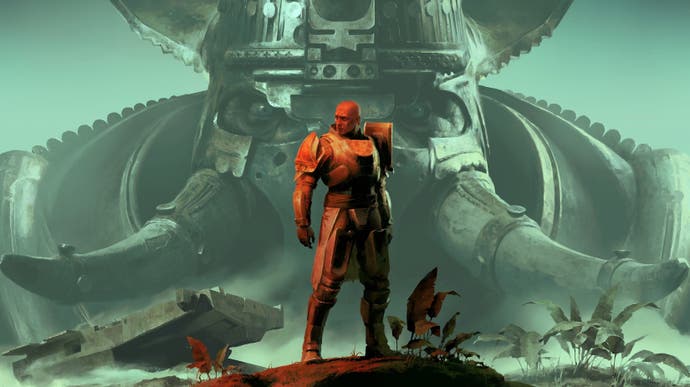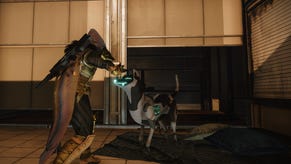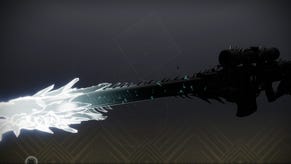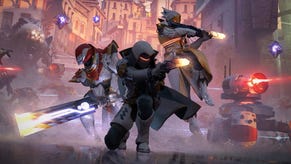Bungie on Destiny 2's Content Vault, solo challenges and the return of Exotic missions
"Forsaken content will be vaulted at some point."
Last month, we spoke with Bungie general manager Justin Truman to discuss Destiny 2's latest major update Season of the Chosen.
We start by talking about the surprise return of Exotic missions in recent weeks. These are secret quests which can be attempted alone or as part of a team, and between their challenge and unique spin on Destiny's mechanics, are up there with dungeons and raids as some of the best activities the game has to offer.
As well as this, how the community has inspired recent solo challenges and the future of live events in Destiny 2, we also discuss the approach for the Destiny Content Vault - an initiative which allows Bungie to cycle out destinations, maps and modes from the game, and also reintroduce things from Destiny's past - starting with the original Destiny's Cosmodrome area in late 2020, and the Vault of Glass raid later this year.
Note this interview was conducted before the studio released an extensive update on its 2021 plans, which saw the delay of the Witch Queen expansion into early 2022, the scrapping of the controversial gear 'sunsetting' feature, and much more - topics we obviously weren't able to touch upon as a result.
I wanted to talk about the Exotic Quests we've had recently, Harbinger and Presage, which have arrived in fairly close proximity - two seasons in a row now. Though the idea of Exotic quests is nothing new for Destiny - we've had Whisper and Zero Hour previously - it's really good to see them return with more regularity. I was wondering - why start doing them again, in the way that you have? What are your goals with these?
Justin Truman: Probably every season that we release is going to have a cool Exotic chase of some form. We've experimented with a lot of different versions, whether that's - we put that behind a dungeon, or we put that behind something in the story, or we build a standalone Exotic mission, or we do something more grindy, right? We're still trying to kind of experiment with different options.
We know when we do something like a secret Exotic mission like Presage, people are really going to enjoy it. So that's always a potential tool in our toolbox. And the challenge we have is we've got so many [tools now], it's like playing an RTS, right? You've got so many resources that you can distribute, and we're trying to figure out for this season - should we put them towards an awesome abandoned ship mission, or should we put them towards some other areas? I think we've been pretty happy with the mix that we've had for Season 13 and Season 12, of where we've distributed our shields.
Definitely. It's a different flavour to this season's activity, which are Battlegrounds, a match-made activity. So to compliment it with something that's quite different in terms of tone and objective feels like a smart move to give players options or different objectives based on what they want to do.
Justin Truman: Absolutely. We don't want to just be telling a singular story over the course of three months without any change in tone. Last season, we had the benefit of telling the Beyond Light storyline and the Season of the Hunt storyline at the same time, so you could hop back and forth between them. For standalone seasons, we want to take the story in an interesting side direction - so it's not just Caiatl, Caiatl, Caiatl.

Something I like about Exotic missions is they all feel quite different. So Harbinger has route changes and you've got feathers to find which change every time, while for Presage, it has a horror vibe, it's integrated into the story of this season, and there's more puzzle solving than you'd usually expect. Raids and dungeons are essentially huge combat puzzles that are co-ordinated with others, but this, you're throwing switches, and getting a buff to get past walls... What is it about these quests that make you think about doing things a bit differently compared to other activities?
Justin Truman: A lot of it comes from what the goal of the experience is. So sometimes we're trying to create an experience that's like - 'Hey, our goal is just to challenge you', so we're just going to come up with this really hard suite of encounters. Usually, when we build a secret, Exotic mission, the goal is to surprise people - obviously, upfront, you want the surprise of like, 'Oh, my gosh, there's a secret in the game'.
But once you get in that mindset of surprising people, you then start thinking about - what would be an interesting thing to happen in these next couple of rooms that you're not used to seeing in Destiny? Once we get in the mindset of surprise, our team comes up with these really amazing ideas - the first time I fell into a trash compactor, and I'm like, 'Wait, what? I didn't know we did that in Destiny'. That's really what we're going for as soon as we say the word surprise.
I was thinking these missions are so enjoyable, and that they seem to be so welcomed by the community, that I'm kind of surprised they're not promoted heavily as part of the season pass ahead of time - but I guess the secrecy and the surprise is a major part of what makes these work, right?
Justin Truman: Yeah. The more we beat the drum about them leading into it, the less surprising they are. And then we have other Exotic content that we do that's like that - we say, 'Hey, this Exotic is coming back', and we're going to tell you about it well in advance. But that tends to be a different type of experience that might be more nostalgic, or more lower base and less surprise-based.
Talking about surprises, one of the things I really enjoyed - and this feels like a minor thing - is the fact the last two Exotic missions aren't timed anymore. Was that a big decision to make? It makes them feel quite different to the missions we've had in previous years.
Justin Truman: We continue to experiment with what's the right degree of challenge, because we've found these are missions that everybody in the community enjoys. So we want everybody to be able to experience these. I especially liked, for myself in Presage, how the entry and the grind to unlock it was really short - it was very quick for you to jump in and be experiencing the ghost ship.
On the other hand, we want it to present enough of a challenge that it encourages social behaviour. The first time I ran through, I could not solo it, so I had to call my friend and then had a fun experience in the evening with a friend I haven't played with in a while, and the mission and challenge level encouraged me to do that.
We're trying to tie that balance, and that balance is different for each person, right? There's definitely people who can solo these missions without worrying about a timer, then there's other folks who need a carry, but we're trying to find the right balance where for most people, it's accessible, but then also encourages fireteaming up.
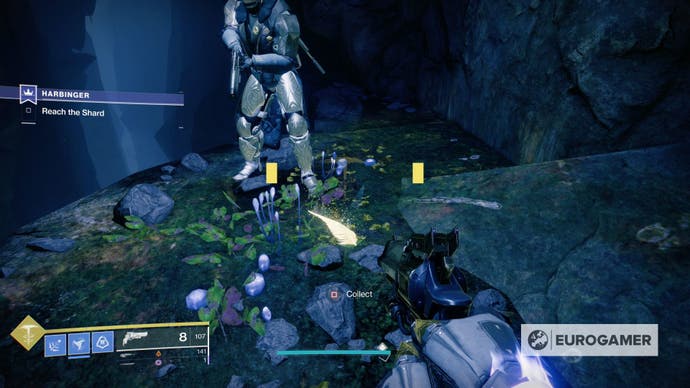
I know Bungie is very metrics and data driven - is that like a response to how players approach the previous missions, or even other activities? Or was it more of a gut feeling or tone that you guys wanted to hit, and you experimented and went from there?
Justin Truman: It's more gut. We certainly see, after we ship an experience, how it performs. We set hypotheses. We think, 'When we do this, a lot of people are going to play it'. And then after we release it, we're like, 'Oh, yeah, a lot of people did play it'. But when we build something new, you can't really use your past metrics - you're really going off of your gut and your player experience of - as a player, if this happened to me, how would I feel? And then if that sounds really exciting, then maybe you build it.
This year we've had seasonal content stick around a lot more, which was a big response to Year 3, and that people experienced FOMO (Fear of Missing Out), and then wanted to revisit stuff throughout the year if they didn't check in the first time round. Does that decision affect the way you've designed and approach these missions as well? They certainly feel more replayable - there's more to come back to every week.
Justin Truman: This is something if you go back to the very beginning of secret missions - they were really amazing experiences that you experienced once and then the replay was to carry your friends. Then we started putting the Catalysts in there to be - what's a version of this you can come back to multiple times and feel more like a ritual? The amount we invest into one of these experiences to make them really great, we'd love it if people spent more than just an hour in them, and then kind of never experienced them again. Right now, all of the content that we have coming out over the seasons this year, we plan to have stick around until the launch of The Witch Queen.
I guess that also addresses a problem of how, say, story missions are only mainly played once by players - it feels a shame how people only go to these areas or experience these activities just the once before moving onto other things. It's a nice way to get the most out of something we've designed and put a lot of time and effort into.
Justin Truman: Yeah, that's the thing I was saying earlier about the RTS game [comparison with studio resources] - we never have as many resources as we want, to build as much content as we would love to build. We're always trying to figure out what is the best way to... you can pour more content into a single experience, and then you make it better and better and better, and then you really exceed people's expectations.
But then ideally, if you do that, you're utilising that content in a really enjoyable way over an extended period of time. What you don't want to do is to spend a third of your budget on a story mission that you play once and never play again - then we're now down to two thirds of our budget to keep you happy for the rest of the season, or the rest of the expansion.
Thinking bigger picture - at the start of Year 4, you vaulted a bunch of planets, and it was justified with metrics explaining 'x percentage players only play this story mission, and it doesn't make sense to have it in the mix', and that you also have to factor them in with balancing and bug checking, and so forth. Has that also changed the way you design things? As in, okay, we want to make sure we get the most out of what we do now?
Justin Truman: When we think about the Destiny Content Vault, we are definitely thinking about the long term health of Destiny. I don't want, as a player, to log into a Director that has 20 planets on it crowding up the screen, and there are eight different Raids that I feel obligated to grind every single week on three characters.
We think there's a healthy, curated amount of Destiny that matches the amount of content you actually want to play in a week. And, it's also better for our ability to iterate and to release content faster, and it's better for players, because then your download sizes aren't like 500 gigabytes or something like that.
With Beyond Light, there was a one time compression, where we got back to what we think is the ideal Destiny Director size. And then moving forward, we plan on keeping that size - so when a new destination comes in, we're probably going to look at the destination that people are the least interested in continuing to play, and pull that back out, so that we can maintain that size, and you don't just steadily bloat over the course of five years.
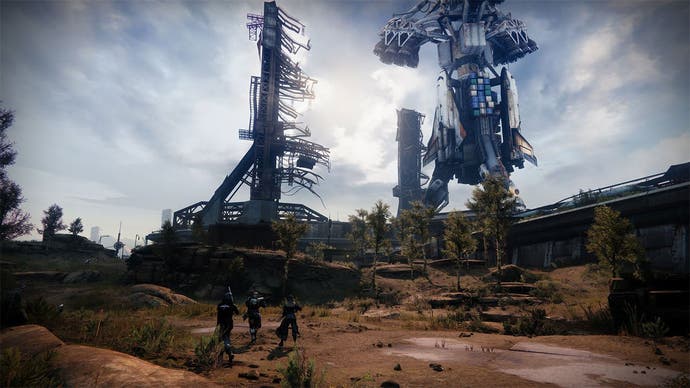
Honestly, there's the piece of this which is the sunsetting, but the piece that I'm really excited about is the Content Vault itself.
I remember playing Sepiks Prime for the first time in Destiny 2, with Destiny 2 abilities, and I haven't played that strike in like five years. It was this awesome rush of nostalgia that is really cool, because we have these memories from older Destiny [content], and I know I'm not the only one excited about like the return of Vault of Glass, which is coming real soon.
By having the Destiny Content Vault, when we take the stuff away, it's not going away forever - it's going into the Vault. This allows us - when we think about a new experience, when we think about the emotions that we want to deliver in a new season or a new year - we can leverage a mix of brand new things that you've never seen before, as well as cool, nostalgic experiences that you're excited to come home to.
I think this gives us the ability to do both, which gives us more options in the future to build awesome experiences.
Yeah - there is a surprising amount of nostalgia for Destiny, and to go back to the Cosmodrome and revisit those spaces could be cool to have in the mix alongside new things. When it comes to vaulting content, how do you judge it so you're not vaulting things too soon? For example, maybe it makes sense for Nessus to go because it's a Year 1 Destiny 2 planet... but I know there was some response from the community that they paid for the base Destiny 2 game, and some of the DLC areas such as Mars, that have since been vaulted. How do you judge that, based on what players have bought, and what feels too soon? For example, will Forsaken content be vaulted at some point? How do you approach that?
Justin Truman: Forsaken content will be vaulted at some point. I think in the same way we don't want eight raids, it's the same thing with storylines - we don't want when a new player enters into Destiny, there's five different competing storylines that they could start playing and in some of them, Uldren's a good guy, and in some of them he's a bad guy, and it's not clear if you're playing them out of order.
We want to curate that experience. We're probably not going to go in strict chronological order - like, oh, the next Destiny 2 destination that came in the launch Destiny would be the next one to vault. Instead, we're thinking about it in terms of - which one of these destinations or experiences is doing the least to the overall healthy ecosystem? And that can range from - which ones have the most exciting experiences that we want to stick around, it could be to do with combatant usage - like, hey, if we get rid of this, there just aren't that many places where Cabal are in Destiny 2 anymore...
Yeah - the EDZ feels like an area that is still pretty active. I still go there to do public events, and we've seen Harbinger set there recently as well. It feels like some areas are more active than others, regardless of when they were introduced.
Justin Truman: I think the EDZ is a good example of one of our oldest experiences - if you chronologically imagine booting up Destiny 2 at launch, it was the very first place you go to, and it's still very relevant in a way that maybe even some newer destinations aren't.
Does that apply the other way round in terms of unvaulting stuff? You're not necessarily looking to get the oldest... obviously, the Cosmodrome was the first experience for many Destiny 1 players, but are you thinking it could be a DLC area, for example, that could be unvaulted next? I assume you're happy to work that way round as well?
Justin Truman: Yeah, absolutely. It's a mix for us of - what are our experiences that we think are really, really cool. We'll tend to approach the Content Vault from a 'best of' approach - what are people's favourite experiences from the past of Destiny? Then the other part is - what are the stories that we're trying to tell now? Because sometimes we'll start trying to tell a story, and then all of a sudden, it'll really make sense for that story to be paired with this piece of vaulted content, or this experience, that we had from the past.
When it comes to seasons over time, how much do you react to data and usage, and also player reactions? How flexible are you? For example, Umbral Engrams returning this season feels like a response to them going down well last summer. Was this the soonest you could implement it, or was it the right time to bring it back?
Justin Truman: Yeah, it felt like the right time to bring it back. We're constantly learning when we work on this stuff. I've been working on Destiny for a decade now, and when I think back at what I thought about what we were doing - even just five years ago - we have learned some much in that time.
Sometimes it's data, right - we make hypotheses about how we think our content is going to do, and how we think players are going to interact with it, then we find out afterwards if we were right or not. A lot of it is also the conversation and the relationship with our community. We can spend 1000 hours iterating and working and play testing something and release it, and within a day, the community has spent 500,000 hours experiencing that and then they likely have very quickly honed in on a key point about something they absolutely love about it, or something that they don't love about it, and we learn from that.
We listen to that. Then we're trying to figure out, okay, what does that mean for future content that we're building and how do we take those learnings and fold them back in?
I imagine seasons last year in general was a big learning experience, because it's the first time you'd had them alongside a battle pass - obviously addressing FOMO was one of those things, and making sure things stick around, but was there any other like big lessons that you learned? Things you thought maybe would go one way when you launched, and the response to it was another?
Justin Truman: FOMO was certainly a big one. We want Destiny to be a living world, we want it to be a world that changes and evolves, and there's moments of history that you want to be present for.
But we didn't want to pair that with this strong sense of FOMO - this strong sense of, I don't log in and put in enough hours right now, my stuff is just gonna evaporate. So that was a case where we missed the mark on that dial.
Umbral Engrams were another really good example where, to me, what those are showing is that people want a little bit more control to tune the rewards that they get, and that's really fun, having a little bit more agency over the rewards you get. That's another one of those dials that is hard to tune, because if we tune that all the way up - if we give you full control - you'll just play an activity three or four times, you'll get exactly the rewards you want, and then now it loses interest. So we want to give you just enough control that you have that fun of Umbral Engrams, but you still have an incentive to keep playing.
To shift gears slightly, I want to talk about solo content - it feels like in Year 4 it's become more of a thing. We talked about Harbinger and Presage - they have solo and solo flawless Triumphs, and we've also got things like the Legend and Master Lost Sectors, and they have rewards for solo play, such as Exotics. Is this something you've wanted to aim for with Year 4, having more solo experiences?
Justin Truman: I think over the long arc of Destiny, this is one of the examples of us learning from the community. We've always thought about our pinnacle content - when we first envisioned Destiny, our pinnacle content is our most social content. It's our raids and our Nightfalls and our dungeons that require you to take a team and be really well coordinated.
Then what we found is that there were some players who reach this further pinnacle of thumb skill mastery, which is, 'I can do the job of my entire bridge crew, just by myself running from terminal to terminal and still captain the ship'. And that is a really cool thing, when we see people do that. That's certainly not for everyone, but for a subsection of our community, that's a really exciting experience. So we just want to support that. We're not not intentionally shifting our focus in that direction, that's just a cool thing that some of our community does that we want to support.
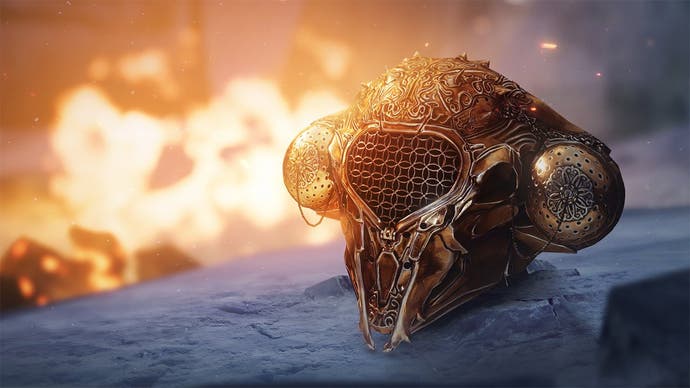
On the Exotics that drop from Legend and Master Lost Sectors. Will they always be tied to those, or will they enter the loot pool eventually? Obviously for some players - as you say - it's a very high end challenge, and they might not be able to get there for various reasons.
Justin Truman: I'm not sure about exactly what our plans for that one are. But I expect that any meta relevant reward that we're going to provide, we want eventually a way for any player to be able to acquire it. We don't want to restrict the play space of verbs to just our highest skill players.
Are you considering more solo focused experiences in future? On the Destiny subreddit, people would love to do strikes on their own, for example. Are things like this something you'd continue to explore as well?
Justin Truman: We talk about that for all types of content. It's a careful balance, though, because I think it can be really fun for someone to try to do something that was clearly meant for multiple people and they accomplish it on their own - that's a cool reward. But on the other hand, we don't want to over time Destiny to become a game that strongly encourages you not to team up.
In fact, typically we want to head in the other direction - which is, whatever you're doing, we would love that to be more fun if you got some friends to join you. That I think is always kind of going to be the north star of how we think about activity content, and we'll just occasionally break that rule with a cool incentive for you to solo and jettison your friends to prove your worth.
Finally, I wanted to chat quickly about live events, which you experimented a little bit with Year 3 - for example, getting everyone in the Tower and seeing a ship come down. Are you done with those? If you are looking to do more, what lessons did you learn and how will you approach them in future?
Justin Truman: We're definitely not done with those. That's definitely something that we were really excited and were happy with the outcome of them. We learned a bunch of things about how hard those are by doing the first two. They're both hard to implement, and they're hard to time perfectly. If you make them a little bit too long, it's really boring, where everybody's just kind of sitting around waiting for Beyoncé to come out on stage, and you're just listening to the warm up act, and that's no fun!
But then if you make them too short, then a bunch of people don't get there in time, and they miss out, because they weren't there during that 10 minute window, or whatever.
We learned a lot from those experiences, and we're really excited to do stuff like those in the future. That, to me, is like those secret Exotic missions, which is, 'Hey, here's another really cool tool in our toolbox'. We just need to figure out the right time to use it, and when we want to focus on this instead of something else that we can be doing.
